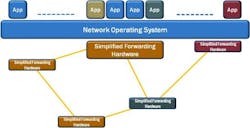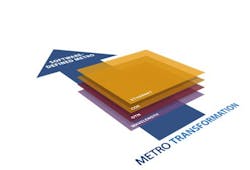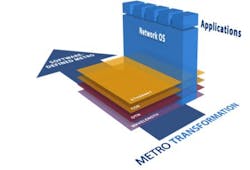Packet-optical transport systems: Platforms for metro transformation
Packet-optical transport systems have gained rapid adoption and wide-scale deployment to support increased traffic and performance requirements for key applications globally. Scalability, performance, and economics have established these new systems as the metro building blocks of choice for wireless backhaul, business Ethernet, broadband backhaul, data center interconnect, and wholesale network initiatives. However, the architectural and operational aspects of these systems are proving far more strategic. In many cases, packet-optical transport systems can provide an ideal foundation for the transformation to software-defined metro networks.
Defining software-defined networks
Let’s start by exploring the concept of a software-defined network (SDN) and the role of packet-optical transport systems to enable a software-defined metro infrastructure. SDN has recently achieved widespread interest for data center applications. The SDN concept is simple and compelling: decouple and open the historically closed hardware and software model of conventional networking products to enable greater innovation and cost reduction.
SDNs employ a centralized control plane, with a common SDN operating system (SDN-OS). South-bound protocols, such as OpenFlow, will enable communication and management control of diverse products from multiple vendors using a common SDN-OS. A centralized control plane will enable common policies to be applied to different equipment, from multiple vendors, across the network.
- Layer 0 (optical/DWDM)
- Layer 1 (Connection Oriented Ethernet-COE, SONET/SDH, and/or G.709 OTN)
- Layer 2 (Ethernet) systems, which collectively support the above as well as other services.
These additional technologies and network layers make the goal of a common, centralized control plane even more complex than in data centers.
Packet-optical transport systems have been purpose-built to support the multiple concurrent technologies used in metro networks. They support advanced Ethernet services, with COE, SONET/SDH, OTN, and/or DWDM/ROADM functions in temperature-hardened platforms sized to scale from the access aggregation edge to multi-terabit platforms optimized for handoff at the core. The ability of these platforms to perform aggregation at one layer and multiplexing and transport using lower layers of the network reduces latency and cost.
An incremental approach to software-defined metro transformation As exciting as this new era of communications sounds, change is always difficult. The reality is no service provider can afford to simply retire all of its existing systems and immediately deploy new software-defined metro networks overnight. Instead, strategies must be established and implemented that systematically fit within short-term business constraints while positioning for the longer-term strategic vision and evolution for sustained profitability. In many cases, the short-term constraints may appear to favor a “more of the same” approach to network and capacity expansion. However, most service providers face a difficult situation in which the current cost of scaling network capacity is growing faster than revenues – leading to an unsustainable business model. Therefore, change is inevitable. The good news is that key applications -- such as wireless backhaul, business Ethernet, broadband backhaul, data center interconnect, and wholesale -- are driving major upgrades or incremental network build outs with good revenue potential. As these case-by-case network enhancements are implemented, they can provide a foundation for transformation. By establishing a clear vision of transformation to software-defined metro networks, service providers are better prepared to select and incrementally deploy point products that satisfy immediate business requirements, yet provide a foundation for software-defined metro transformation. Fortunately, innovative new packet-optical transport systems provide the rare opportunity to do both.Frank Wiener is the vice president of marketing for Cyan, a developer of purpose-built packet-optical transport systems. Prior to joining Cyan in 2008, Wiener held a range of individual contributor and executive leadership roles spanning engineering, product management, marketing, sales, and general management at Nortel, AT&T/Paradyne, and Calix.



